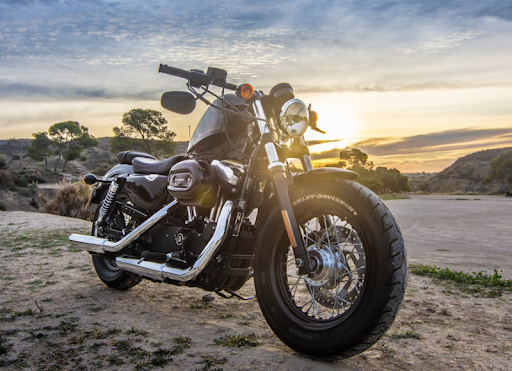As one of the oldest bike brands, Harley Davidson has attained an iconic status and cult following. The Motor Company has churned out hundreds of fan favourites throughout its century-long history, with cruisers and touring bikes making the majority of sales. It has also put innovation at the forefront of bike design.
Simple yet practical additions like the “jiffy” stand (patented in the 1930s) are still in use today. That’s a testament to how good the initial design was, with the stand taken up by rivalling bike brands or copied by aftermarket parts makers. Buyers can now get third-party Harley Davidson kickstands that offer much of the same practicality (balancing a 1000-pound parked bike on uneven ground) with kickstands in different sizes, materials and designs, and for different bikes and riders.
Get Your Harley Standing in a Jiffy

Jiffy stands have endured the test of time because of the brilliance of their design. The term essentially refers to a “side” or “kick” stand (terms picked up later on) that balances the bike in no time (or in a jiffy) with a simple kick. Mounted on the left side of the Harley, the stand deploys when nudged, and locks into place using the weight of the bike. Think of it as a tripod, with the tyres making the two other balancing points. Once in a locked position, the jiffy stand ensures the bike will only move when weight is moved off the stand. A simple nudge forward disengages the spring holding the stand in a locked position, and off you go.
This means Harleys with a stock jiffy, will remain standing on inclines or descents, and not tip over. Something seasoned Harley riders don’t think much about, but can catch new riders or those moving to Hogs from other bike brands off guard. The Motor Company has refined and revised Harley jiffy stands to include adventure stands for the Pan-America with a larger footprint for added stability on loose ground, and jiffy extensions if you change the ride height, for instance with lowering springs or new forks.
What are the Alternatives?
Jiffy stands were meant for short stops and were popular in police edition bikes. But there have also been a few complaints. With Harleys getting bigger and heavier, the stand does show its limitations. Fully loaded bikes can sway or tip over when parked on soft ground or uneven tarmac. Some riders will also find it too short, or that the contact point requires a bigger footprint for added stability. Simple and inexpensive fixes like extenders, jiffy coasters or lift brackets are easy to get on and effective. There are also replacements for worn-out bushings or springs that restore functionality, again in a jiffy.
While there are stock workarounds, many riders will opt for aftermarket Harley kickstands. These deal with most issues surrounding stability, and questionable build quality in Harley’s newer bikes and complement the look of your Hog, especially when matching them with other aftermarket mods and upgrades. There are dozens of dedicated brands to change anything you don’t like on your bike.
If you find the standard jiffy stand a bit too flimsy, taxing to work, unstable on gravel or soft ground, and not a looker, then absolutely go the aftermarket route. When buying consider overall lengths, materials, build, and how the kickstand fits the bike. Standard lengths are 11″ providing the same lean and 45-degree stand angles (relative to the ground) as the standard jiffy, but with increased footprints for improved stability. Lowered kickstands start at 10″, while bikes with a raised ride height for taller riders can be better off with 12″ variants.
Materials range from high-grade stainless steel in black matte, powder-coated or glossy chrome finishes to eye-catching forged or billet polished brass. Consider design features like additional foot pads for bigger and heavier bikes, and longer and more accessible kick tabs to engage springs and pull the stand in position faster and easier.
Also, choose lean angles that suit the weight of the bike. Variants with less lean will get the bike level easier using less effort. Lastly, consider mounting hardware and installation. Most aftermarket stands are direct jiffy stand replacements and fit the frame with the supplied hardware. Others may require welding.
The Advantages of Aftermarket Seats
For improved riding comfort, one of the first upgrades is aftermarket seats. Let’s be honest, the different factory options (from the Sundowner, Signature, Hammock or Road Zeppelin series) are absolutely fine in bikes rolling off dealer floors, but the build, materials and padding start to show their worth after a few thousand miles. Sagging, torn and ungainly seats are not only uncomfortable over longer stretches, but they also up fatigue and numbing, increase distractions and can soon be a safety hazard.
Just like Harley Davidson kickstands, aftermarket seats offer more convenience, the choice of different styles and materials, and an easy way to get more out of your bike. And they’re built to a much higher standard while still undercutting stock options for price. Consider the improved rigidity of stainless steel in parts like pans that hold the seat together, the higher-density or gel foam padding for improved thigh and lumbar support, and weather, impact and tear-proof seat covers in materials like high-grade vinyl or leather to withstand rider weight, constant friction, and direct exposure to sunlight or rain.
Additionally, change the stock seat to suit your riding habits with different sizes. Choose larger, and better-padded extended solo seats if you ride alone and want more space, 2-up seats with included back and rear armrests for all-round comfort or springer seats in custom rebuilds and for improved vibration isolation. And from the huge assortment of seat accessories, ranging from heating, backrest pads, height adjustability and locking options.
Improved Grip with New Tyres

The factory touring or cruiser tyres that came with a new Harley will eventually need to be replaced if you value performance and safety. Bike tyres last anywhere between 3,000 and 10,000 miles, depending on your riding style, tread and tyre types, road conditions, and how much maintenance you put into them. Regularly check rubber for wear, tread depth, road debris and cuts and cracks in the sidewalls. Also, look for wear near the rims, and observe the correct pressure for the weather and road conditions.
There are crucial design and performance differences for tyres suited to different Hogs. Touring bikes wear tyres optimised for longer mileage and traction. They have flatter profiles that aid straight-line stability, while also being made of multi-ply and harder compounds that work in most types of weather.
Cruiser tyres differ somewhat with rounder edge profiles and stiffer sidewalls for better cornering ability, but still consist of harder compounds that provide the need traction on wet roads. Both need to support much more weight than flimsy, slick tyres usually found in featherweight sports bikes.
Match tyres to rim sizes and widths, choose tread patterns for the areas and weather you usually ride in, and ensure you’re buying rubber recently made, but no older than six years. Store new or unused tyres in dry, enclosed areas, preferably at room temperature and away from moisture.







